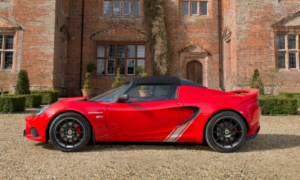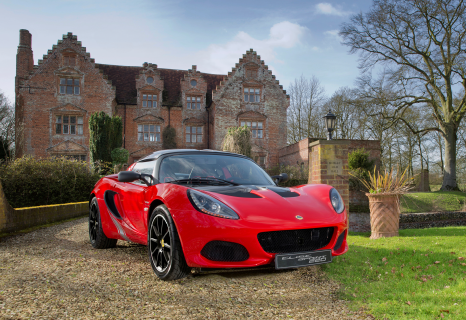• New Generation Model Year 17.5 Elise Range
• New iteration of hand built Lotus sports car includes new Sprint edition model
• Sprint adds carbon fibre to cut 40 kg and hit 798 kg dry weight
• New front and rear design, and significant interior upgrades across the model range
• Available to order now
Evolved, energised and even lighter, a significant update for the legendary Lotus Elise has been unveiled ahead of its arrival in showrooms this spring.
Pride of place in the latest Elise line-up is the new Sprint edition, capturing the spirit of Lotus by offering the latest in efficient engineering to deliver a car that sets the standard at under 800 kg. Featuring a host of weight-saving items as standard, as well as the Elise’s distinctive new styling, the new Lotus remains true to the company’s founding principles. Benefitting the range as a whole, all new Elise editions receive the car’s new look and new interior options, and every single one of the Sprint’s lightweight components can be specified on the standard Elise Sport and the Elise Sport 220 variants.
In the biggest weight cut to the car since the introduction of the first-generation Elise, Lotus has returned to its roots by employing the same intense engineering strategy as used on its most recent models. The Sprint edition of the Lotus Elise has removed 40 kg from the previous model, to reach a benchmark dry weight of just 798 kg.
Integrating a new front and rear aesthetic with Lotus’ established design language, this latest Elise also receives a wide range of cabin enhancements – including the lightweight open-gate gear select mechanism first introduced on the Lotus Exige Sport 350. The Sprint is available in both the 1.6-litre naturally aspirated and 1.8-litre supercharged versions. Delivering an exciting mid-point in the range, it broadens the car’s appeal by including lightweight and carbon components as standard.
The Sprint and the spirit of Lotus
Ensuring that this latest Elise remains true to the company’s DNA, the return for the Sprint badge – as used on historic models including the Elan – is designed to provide a highly attractive super-lightweight option sitting above the respective Elise Sport models, and below the top of the range Elise Cup 250.
The Sprint’s standard lightweight components include a Lithium-Ion battery, saving 9 kg, Lotus’ beautifully detailed carbon race seats, 6 kg, new lightweight forged alloy wheels, 5 kg, while the carbon access panel, roll hoop cover and engine cover, and polycarbonate rear screen save 6 kg. Collectively they cut an impressive 26 kg, compared to the previous Sport and Sport 220 models, and together with the improvements made to the whole Elise range bring the weight of the new Elise Sprint down to just 798 kg (dry). This includes new, optional two-piece brake discs, saving 4 kg, which will be available from May this year and optional carbon sill covers. This reduction in weight translates into quicker acceleration (with 0-60 mph in 5.9 seconds and 4.1 seconds for the Elise Sprint and Elise Sprint 220 respectively), harder cornering and a power to weight ratio of up to 168 hp / tonne (Elise Sprint) and 257 hp / tonne (Elise Sprint 220). Lotus’ acoustic engineers have spent time altering the aural appeal of the Elise with the fitment of a new exhaust system on the more powerful Elise Sport 220 and Elise Sprint 220 model variants.
External design touches for the Sprint range include a matt black transom panel, black wheels which come with custom contrasting metal spun rims, distinctive yet subtle side stripes on the bodywork and unique side and rear badging.
Other highlights comprise bodywork keyed colour inserts for the sports seats, transmission console and HVAC surround, along with Sprint badge stitching. The Sprint’s detailing continues inside with an array of optional Alcantara® trim panels on the doors, sills, seats and vents surrounds, all with contrasting stitching.
Less mass means more Lotus
Modifications front and back are more than skin deep and have allowed the careful balancing of aerodynamic downforce across the whole car. Rubber elements mounted on the flat underside and ahead of the front wheel, together with an additional diffuser vane at the rear, help modify airflow under the car reducing drag and increasing stability.
The cabin also benefits from a new centre console, as seen on the Exige and optional carbon sill covers which reduce weight by 0.8 kg and increase the door aperture by up to 10 mm, aiding ingress and egress. The Elise’s instrument panel has also received attention, with new graphics making it easier to read and a new in-car entertainment system, including iPod® connectivity and Bluetooth® functionality, can also be selected when ordering.
In addition to injecting some visual drama into the new Elise’s cabin, Lotus’ beautifully detailed open-gate manual gearbox also provides a much more positive and direct operation – giving more precise and quicker shifting. Both technically and aesthetically appealing, thanks to the exposed open-gate design, it further reduces weight with a net saving of 1 kg. An evolution of the design first used on the Exige Sport 350, but specifically optimised for the Elise, it perfectly matches the Lotus’ personality.
The cabin also benefits from a new centre console, as seen on the Exige and optional carbon sill covers which reduce weight by 0.8 kg and increase the door aperture by up to 10 mm, aiding ingress and egress. The Elise’s instrument panel has also received attention, with new graphics making it easier to read and a new in-car entertainment system, including iPod® connectivity and Bluetooth® functionality, can also be selected when ordering.
Options for the new car include Alcantara® trimmed steering wheel, vent-surrounds and sills. Further enhancement can be specified, including a new paintwork colour: “Electric Light Blue” joining the Lotus core colour range.
The new Elise Sport and Sprint are available in two engine options: the 1.6-litre or the supercharged 1.8-litre. Offering 134 hp / 160 Nm of torque and 217 hp / 250 Nm of torque respectively, they have been specifically tuned to suit the Elise and both help to deliver a benchmark power-to-weight ratio and class leading efficiency. Being so lightweight, emissions are extremely low with 149 g CO2 / km and 173 g CO2 / km for the 1.6 engine and 1.8 engines respectively.
Stopping power is provided by AP Racing twin-piston front calipers and Brembo single-piston rear-calipers – optional lightweight two-piece brake discs are also available. All cars benefit from user selectable ESP driving modes – Drive / Sport / Off.

Retaining the elements that have always kept the Elise ahead of rivals, the car is built around an extruded and bonded aluminium chassis which is both tremendously strong and torsionally stiff – weighing just 68 kg.
The new Elise also carries over the same suspension setup as before, with fully independent double wishbone suspension and a front anti-roll bar, coupled with Bilstein high-performance gas dampers and Eibach coaxial coil springs front and rear. Being lighter than the preceding model, the effective spring rate is marginally increased, retaining the compliant ride for which all Lotus cars are legendary.
Designed to continue the legacy of the Elise as Lotus’ most popular model ever, the new Elise MY17.5 range can be ordered today – with deliveries starting from late April 2017.
A new Lotus Elise Cup 250
A new version of the Elise’s most popular model, the Cup 250, will be released in May 2017. Also incorporating all the Elise range updates, the Elise Cup 250 model is a massive 23 kg lighter than its predecessor, with lightweight options including a Carbon Aero pack, front access panel, roll hoop cover and engine cover to take this to 40 kg, providing even more blistering performance. Further press information will be available closer to the car’s release, but customers can order the new Cup 250 today.

